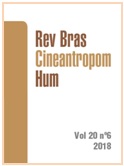Body Mass Index as a predictor of multimorbidity in the Brazilian population
DOI:
https://doi.org/10.1590/1980-0037.2018v20n6p555Abstract
Overweight is a health risk indicator, but little is known about its influence on the chronic non-communicable diseases (NCD) multimorbidity. The aim of this study was to identify the predictive values and sociodemographic factors associated with Body Mass Index (BMI) as a determinant of the occurrence of NCD multimorbidity in Brazilian men and women. Data from the “Surveillance of risk and protection factors for chronic diseases by telephone survey” - 2013 national survey were used. The population was composed of ?18 year-old individuals and those living in house with a fixed telephone line in the 27 Brazilian’s capitals. The outcome variables were BMI and its respective predictive value for the occurrence of multimorbidity (?2 NCDs). The exposure was age, marital status and educational level. Inferential statistics included the construction of Receiver Operating Characteristic curves (cutoff point defined by sensibility [Se] and specificity [Sp]) and the association by Poisson Regression, stratified by sex. The values with the best predictive capacity for multimorbidity were 26.7 kg/m² (Se = 60.9%, Sp = 60.2%) for men and 25.7 kg/m² (Se = 61.8%, Sp = 61.1%) for women. The predictive multimorbidity value followed the progress of age groups up to 55 to 64 years for both groups. Women with higher educational level showed an inverse association for the presence of the outcome. BMI can be considered a predictor of the occurrence of multimorbidity, and sociodemographic profile associated with this predictive value was advancement age and inversely associated with educational level in women.References
World Health Organization. Global status report on noncommunicable diseases 2014. Suíça, 2014; Disponível em: http://www.who.int/nmh/publications/ncdstatus-report-2014/en/ [2017 ago 26].
Falagas M, Vardakas K, Vergidis P. Under‐diagnosis of common chronic diseases: prevalence and impact on human health. Int J Clin Pract 2007; 61(9):1569–79.
Duncan BB, Chor D, Aquino EML, Bensenor IM, Mill JG, Schmidt MI, et al. Chronic non-communicable diseases in Brazil: priorities for disease management and research. Rev Saúde Pública 2012; 46(1):126–34.
Brownell KD. Obesity: understanding and treating a serious, prevalent, and refractory disorder. J Consult Clin Psychol 1982; 50(6):820.
Powers SK, Howley ET. Fisiologia do Exercício: Teoria e Aplicação ao Condicionamento Físico. São Paulo: Manole; 2000.
Ribeiro Filho FF, Mariosa LSS, Ferreira SRG, Zanella MT. Gordura visceral e síndrome metabólica: mais que uma simples associação. Arq Bras Endocrinol Metabol 2006; 50(2):230-8.
Twells LK, Knight J, Alaghehbandan R. The relationship among body mass index, subjective reporting of chronic disease, and the use of health care services in Newfoundland and Labrador, Canada. Popul Health Manag 2010; 13(1):47–53.
Goyal A, Nimmakayala KR, Zonszein J. Is there a paradox in obesity? Cardiol Rev 2014; 22(4):163.
Barnett K, Mercer SW, Norbury M, Watt G, Wyke S, Guthrie B. Epidemiology of multimorbidity and implications for health care, research, and medical education: a cross-sectional study. Lancet 2012; 380(9836):37–43.
Jakovljevic M, Ostojic L. Comorbidity and multimorbidity in medicine today: challenges and opportunities for bringing separated branches of medicine closer to each other. Psychiatr Danub 2013; 25(1):18–28.
Boutayeb A, Boutayeb S, Boutayeb W. Multi-morbidity of non communicable diseases and equity in WHO Eastern Mediterranean countries. Int J Equity Health 2013; 12(1):60.
Smith SM, Soubhi H, Fortin M, Hudon C, O’Dowd T. Managing patients with multimorbidity: systematic review of interventions in primary care and community settings. BMJ 2012; 12 (9):345:5205.
Brasil. Ministério da Saúde. Sistema de Vigilância em Saúde. VIGITEL. Brasil 2013: Vigilância de fatores de risco e proteção para doenças crônicas por inquérito telefônico. Brasília 2014. Disponível em: http://bvsms.saude.gov.br/bvs/publicacoes/vigitel_brasil_2014.pdf [2017 set 09].
Schisterman EF, Faraggi D, Reiser B, Trevisan M. Statistical inference for the area under the receiver operating characteristic curve in the presence of random measurement error. Am J Epidemiol 2001;154 (2):174–79.
Pathirana TI, Jackson CA. Socioeconomic status and multimorbidity: a systematic review and meta-analysis. Aust N Z J Public Health2018; 42(2):184-94.
National Institutes of Health. Clinical guidelines on the identification, evaluation, and treatment of overweight and obesity in adults: the evidence report. Obes Res 1998; 6(2):51–209.
World Health Organization. Diet, nutrition and the prevention of chronic diseases: report of a joint. Suíça 2003. Disponível em: http://apps.who.int/iris/bitstream/10665/42665/1/WHO_TRS_916.pdf [2017 nov 14].
Strong K, Mathers C, Leeder S, Beaglehole R. Preventing chronic diseases: how many lives can we save? Lancet 2005; 366(9496):1578–82.
Fortin M, Bravo G, Hudon C, Vanasse A, Lapointe L. Prevalence of multimorbidity among adults seen in family practice. Ann Fam Med 2005; 3(3):223–28.
Macedo J, Stampini Duarte Martino H, Scareli Fernandes MF, Silva Costa L, Ribeiro Silva R. Avaliação nutricional e prevalência de doenças crônicas não transmissíveis em idosos pertencentes a um programa assistencial. Ciênc Saúde Coletiva 2008;13(4):1231-46.
Brasil. Instituto Brasileiro de Geografia e Estatística. Características da População e dos Domicílios–Resultados do Universo. Rio de Janeiro 2011. Disponível em: https://biblioteca.ibge.gov.br/visualizacao/periodicos/93/cd_2010_caracteristicas_populacao_domicilios.pdf [2017 ago 28].
Lacerda EM. Fatores associados com a retenção e o ganho de peso pós-parto: uma revisão sistemática. Rev Bras Epidemiol 2004;7(2):187-200.
Pedro AO, Pinto Neto AM, Paiva LHS da C, Osis MJ, Hardy E. Idade de ocorrência da menopausa natural em mulheres brasileiras: resultados de um inquérito populacional domiciliar. Cad Saúde Pública 2003; 19(1):17-25.
Orsatti FL, Nahas EAP, Nahas-Neto J, Maestá N, Padoani NP, Orsatti CL. Indicadores antropométricos e as doenças crônicas não transmissíveis em mulheres na pós-menopausa da região Sudeste do Brasil. Rev Bras Ginecol Obstet 2008;30(4):182–89.
Prazeres F, Santiago L. Prevalence of multimorbidity in the adult population attending primary care in Portugal: a cross-sectional study. BMJ 2015; 5(9):009287.
Robles TF. Marital quality and health: Implications for marriage in the 21st century. Curr Dir Psychol Sci 2014;23(6):427–32.
Barros MBA, Francisco PMSB, Zanchetta LM, César CLG. Tendências das desigualdades sociais e demográficas na prevalência de doenças crônicas no Brasil, PNAD: 2003-2008 Ciênc Saúde Coletiva 2011; 16(9):3755-68.
Habibzadeh F, Habibzadeh P, Yadollahie M. On determining the most appropriate test cut-off value: the case of tests with continuous results. Biochemia medica 2016; 26(3):297-307.
KleinCH, Costa EDA. Os erros de classificação e os resultados de estudos epidemiológicos. Cad Saúde Pública 1987;3(3): 236-49



